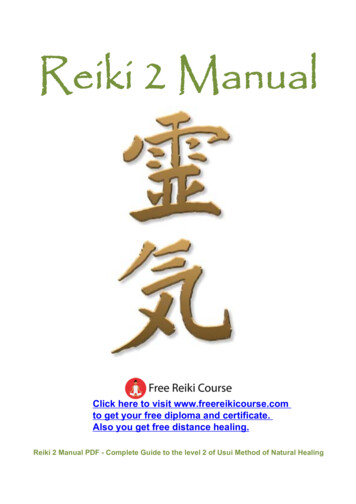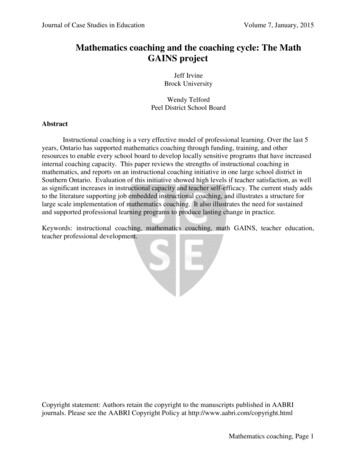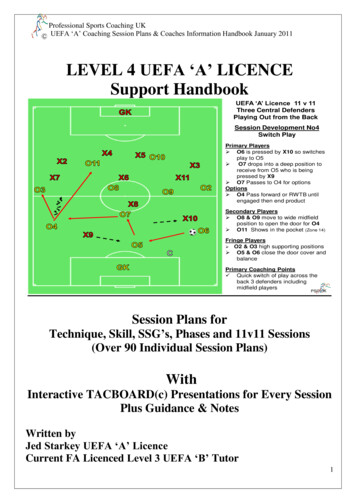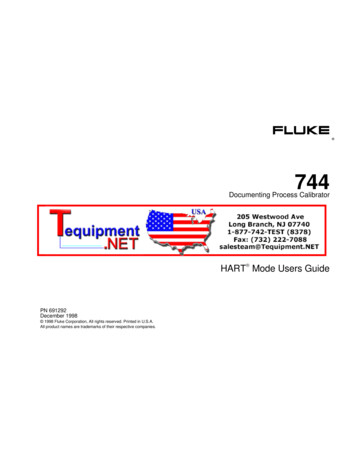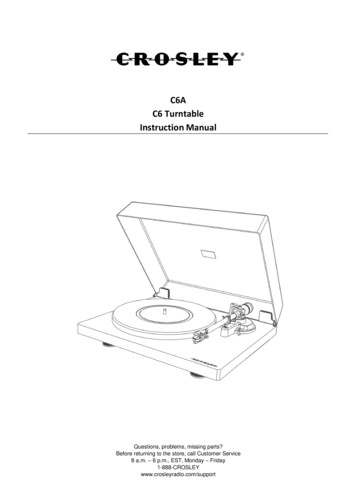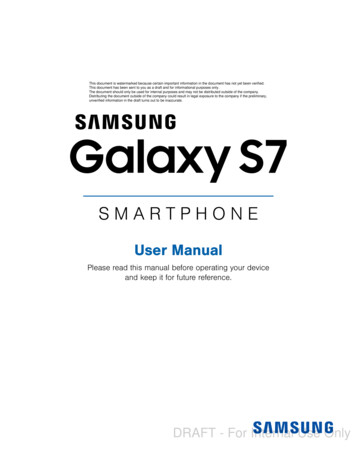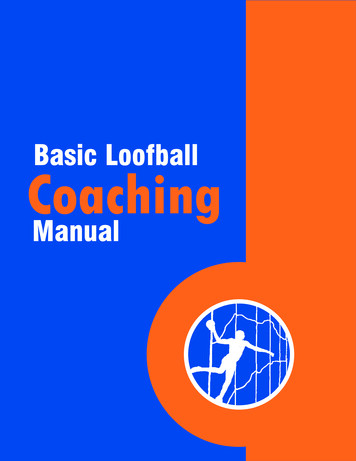
Transcription
Basic LoofballCoachingManual
Basic Loofball Coaching ManualA CompleteGuide to Coaching AthletesPublished Bywww.lsd-initiative.org info@lsd-initiative.org
FOREWARDThis coaching manual has been developed by Loofball Sport DevelopmentInitiative (LSD Initiative) as part of her commitment to ensuring the success ofloofball at the grassroots level as well as the seamless implementation of theorganization’s programmes and policies.The manual provides coaches and trainers with relevant information on how toproperly coach loofball so that athletes can enjoy the maximum benefits ofplaying the sport - getting physically active, healthy and fit. It also providesinformation on managing practice sessions, basic skills development and bestapproaches to coaching children.Coaches and trainers are therefore required to utilize this resource to coach inline with the expectations of LSD Initiative and ensure that young athletes arebeing taught the correct skills and attitudes in a fun and friendly environment.LSD Initiative would like to express her sincere appreciation to the draftingcommittee, her ever-supportive Advisory Board and some of the volunteers, whocontributed in a way to ensuring the success of this project.Basic Loofball Coaching ManualI
TABLE OF onCoaches Code of EthicsYour Role as a CoachSkills Required of a CoachUnderstanding the GameRules of the GameTeaching Loofball SkillsSystems of PlayCoaching in Practice SessionsWarm-Up and Skills DrillsCoaching in MatchesTalent IdentificationPlayer Development ModelCoaching ChildrenInjury ManagementPlayer Evaluation11245610172224303133363740Basic Loofball Coaching ManualII
IntroductionSport and physical activity is a fundamental aspect of human life. The benefitsthat come from it are multidimensional. Sport and physical activity is often seenas a medium through which valuable life skills such as teamwork, dedication,perseverance and healthy lifestyles can be taught. The health, social andeconomic importance of physical activity in particular cannot be overstated.Evidence shows that lack of physical activity increases the risk of heart disease,colon and breast cancer, diabetes mellitus, osteoporosis, anxiety anddepression, hypertension and other life-threatening diseases.Loofball is a scientific sport designed with health and safety considerations tomeaningfully engage participants. It is the coach, however, who shapes theexperiences of players and steers both their athletic and individual development,hence the need for this coaching guide.This Basic Loofball Coaching Manual has been developed as a guide forcoaches to ensure that young players are taught the correct skills and attitudesthe right way, and that progress is made in the sport. The document will be ofinterest to all loofball coaches and trainers, school officials, teachers,researchers, parents, affiliates of LSD Initiative, other sports organizations andanyone interested in sport and physical activity.Coaches Code of EthicsLSD Initiative is committed to the highest ideals of sport and expects her coachesto act in a manner that contributes to the overall mission and goals of theorganization. Coaches must realize that they are not only instructors but criticalpartners who contribute to both athletic and individual development of players.This is vital to note because how a player regards a sport is often dependent onthe behavior of the coach. The following Code of Ethics outlines theresponsibilities of coaches and serves as an important guide in developingplayers as well as enabling them become better both as athletes and individuals.Coaches have the responsibility to:· Be aware of, and always comply with, the LSD Initiative Safety Policies andGuidelines. The safety, health and welfare of players should always come first.Basic Loofball Coaching Manual1
· Treat everyone fairly regardless of gender or gender identity, age, ethnicity,disability, political, religious or social background. Bullying, harassment ordiscrimination of any kind is forbidden in loofball.· Be aware of, and always comply with the LSD Initiative Child Protection andSafeguarding Policy and Guidelines.· Maintain a thorough knowledge of the rules of the game.· Actively discourage unsportsmanlike behaviour of players.· Maintain appropriate, professional relationships with players at all times.· Direct comments or criticism at the performance rather than the athlete.· Ensure that the activity being undertaken is suitable for the age, experience,ability and fitness level of athletes.· At no time become intimately or sexually involved with their athletes. Thisincludes requests for sexual favors or threat of reprisal for the rejection of suchrequests.· Not act in a way that may adversely affect or bring you, your team,organization or the game into disrepute or discredit.· Not encourage, promote or turn a blind eye to any fixing or attempt tocompromise the outcome of a match at any given time.· Disclose any incident that does or has the potential to render you unfit to be aregistered coach or violates LSD Initiative’s core values, irrespective of whensuch event took place.Your Role As A CoachA Role ModelThe coach has to be a good role model to the athletes. The way you conductyourself whilst in the presence of your athletes provides an example of how theyshould behave. Being a good role model will help, for example, make the playerslisten and take in what you’ve got to say. A coach has to be someone who otherindividuals would aspire to be like, either in the present or future.An InnovatorA successful coach develops training techniques and styles that are appropriatefor teams and/or players. A coach should be able to invent practice methods thatbuild on and encourage teamwork and skills development. A coach's creativitycan inspire his team to perform better both individually and as a group.Basic Loofball Coaching Manual2
An EducatorIt is important to note that athletes learn in different ways, and that learning is aprocess of adaptation. A good coach tries to train athletes and provide instructionthat is adapted to the athlete's level. It is the coach's responsibility to try to helpyoung athletes to grow and become better both as athletes and individuals.Athletes may face temptations and could feel pressure to take part in unhealthyor delinquent activities such as usage of drugs, alcohol etc. The coach should bethere to guide them into making the correct decision when these kinds oftemptations occur.A MotivatorThe coach is required to create the environment and opportunity for athlete toexpress their motivation in all they do. The coach should refrain from just usinginsults and bad language to achieve this; instead he should establish a playerfriendly strategy to get the best out of players. It is the strength and the characterthat allows athletes to overcome adversity, setbacks, disappointments andinjuries. For instance when a player does something wrong, the coach canexplain and advice them how to do it next time; it could also be an off the pitchsituation wherein the coach advises his players. The players need to see thecoach as someone they can look up to and can lead them into success.A FriendIt is always important to be a friend to your players as, at the end of the day,we’re all humans. Being a friend can make a player feel better when receivingcriticism because they know it’s only about improvement which is important. Thecoach must, however, ensure the player knows the boundaries and still respectstheir authority.Duty of CareCoaches have a duty of care to safeguard children and young people from harm.Every child has the right to experience and enjoy sport in a safe environmentwithout fear of bullying or abuse from others around them. As a coach, you havethe obligation to ensure that this environment is created. The physical, emotionaland psychological well-being of athletes should always be a top priority for anyloofball coach.Basic Loofball Coaching Manual3
Health and SafetyCoaches must ensure that all reasonable steps are taken to create a safesporting environment. A good coach should try to ascertain the well-being andsafety of his athletes at all times. Ensuring athletes’ safety can be achieved byinspecting playing court before games or sessions, monitoring players both onand off the court, asking questions when need be as well as having goodknowledge of abnormal body signs.ProfessionalismCoaches are required to display high personal standards and always show afavorable image of the game and of coaching to athletes, other coaches,spectators and the public. Coaches should treat all athletes with absolute dignityand respect as free and equal individuals. They should encourage athletes to actin a similar manner, including ensuring dignified behaviour in victory and defeat.The coach must not exert undue influence over the athlete in order to obtainpersonal benefit whatsoever.Equal opportunitiesIt is important to make sure that everyone is given the same chance to make itinto the team. Factors such as race, gender, religion, social or economic statusand ability should never impact the coach's decision on whether a player shouldbe given an opportunity to learn the sport. It is important to make sure there isequal opportunity as you never know where fresh talent is going to come from.During a training session, the coach should cater to the needs of all players andnot give preference to a selected few. This is because it will make the segregatedones feel unwelcome. In terms of competitions, however, selection should bebased only on skill and attitude.Skills Required Of A CoachCommunicationA coach should have good communication skills which involve talking clearly toathletes and also listening to what they have to say. Merely giving institutions toplayers isn't enough. The coach should ensure players clearly comprehend andunderstand exactly what he's saying.Basic Loofball Coaching Manual4
OrganizationPlanning and organization can help keep athletes engaged and enthusiastic. Thecoach will need to have a system of conducting sessions to help athletes improveand master basic skills. This will include planning sessions before hand andmaking sure they run smoothly.Time managementAs a coach, you need to be good at managing time, for example knowing wherethe players need to be at a certain time. Time management of a session can varydepending on the intensity or seriousness of the session. The coach needs toknow when enough’s enough, and also the time it could take to get to a venueleaving enough time to warm up and get ready for the game.Self-AwarenessThe coach needs to maintain self-awareness and humility at all times. Coacheswho are self-aware and humble set model behavior for their players to follow.Through a coach’s analysis of themselves and their players, innovative coachingmethods can be discovered to improve and enhance player and teamperformance.Understanding The GameLoofball is an interesting non-contact sport which is played over a net with a furryball by five players on each side of the court. A play or combat begins with aserve and ends with a scoring or fault. A loofball match is won by the first team towin two sets. The first two sets are played to 25 points, whereas the third set isplayed to 20 points.A Brief History of LoofballThe game’s origin dates back to 2017, when it was played as a pastime byschool kids in Numan, Adamawa State, North-East Nigeria. The game wasinitially played over an extended rope between two to five players until early2018, when ropes were replaced with nets. However, the game evolved rapidlyand enjoyed significant popularity among youths in neighboring states and theFederal Capital Territory.In a society accustomed to more established sports like football, basketball andvolleyball, loofball needed a holistic and organized approach to succeed. To thisBasic Loofball Coaching Manual5
end, the Loofball Coaching Team, a group of passionate volunteers, was formedin 2018 to develop and propagate the sport at the grassroots level. The group,which would be later incorporated as a non-profit organization with the officialname - Loofball Sport Development Initiative, made remarkable strides indeveloping as well as administering the sport by using systems and strategiesthat apply to the modern context.The rules of the game were first drafted by Engr. Winner Vidiyeno Matahula, asafety and health expert, an avid sportsman and a writer.Aim of the GameThe objective of the game is to launch the ball over the net with such speed anddirection so that the opponent fails to catch or return it. There are basically threephases of play: service, attack and defense. During service, the team with theball serves into the opponent’s home zone. Attack happens when a team tries todown the ball on the opponent’s court, whilst the opponent tries to defend orprevent the attacking team from scoring. A team scores a point when the balllands on the appropriate zone or section of the opponent’s court, or when theopponent fails to return the ball by committing a fault.SafetyAs a non-contact sport, the likelihood of physical contact in loofball is very low.This, however, does not prevent the likelihood of injury. Players should beencouraged to always stick to the rules of the game at least as a preventivemeasure against avoidable injuries.Most likely injuries in loofball include sprained shoulder, sprained ankle and kneeinjury. (See Injury Management)Rules Of The GameAs a fast-paced non-contact sport, loofball requires athletes and coaches tounderstand and master the rules of the game, to avoid errors or simply put,gifting points to the opponents. Below are basic play rules of loofball.Basic Loofball Coaching Manual6
Rules of Play················There are five players on each side of the court.Before service, players arrange themselves (within the home zone) in rows three players in the front and two at the back.Contact with the ball is by the hand or forearm. In other words, the ball mustnot touch a part of the body other than the hand and forearm before it is held.A player takes no more than two steps with the ball.A player does not hold or throw the ball more than once within a turn.A shot or serve is launched with one hand.A shot launched from the home zone is valid only when it reaches theopponent’s home zone.A lob is valid only when it reaches the diagonally opposite section of the forezone or the opponent’s home zone.A player must not overreach the net when lobbing or jump-shooting.Jump-shooting (during play) is allowed only within the home zone.Minimum of two and maximum of three throws in a turn.A player must not hold the ball beyond 3 seconds.In a set, the winning team serves next.A ‘line ball’ is in.Only one player is allowed to catch or hold the ball at a time.A serve is valid only when it reaches the opponent’s home zone. Moreover, aserve must not result in a ‘net ball’ nor ‘high-ball’.ScoringA match is played as best of three sets i.e. winning the first two sets wins thematch. The first two sets are played to 25 points whereas the third set is playedto 20. A set must be won by a point margin of 2. Each combat won earns a point.To win a combat, the opponent must commit a fault or fail to return the ball.Court sizeLoofball is played on a rectangular court measuring 17m by 8m separated by anet in the middle. The home zone on each side of the court measures 5.9m x 8m.The fore zone, a quadripartite region separating the home zones, measures 5.2mx 8m. The fore zone also incorporates a 2m diameter sub-region (called Olive) atits centre.Basic Loofball Coaching Manual7
Net Size and HeightA net, preferably of white or black color, 1 m wide and 8.5 m long with mesh sizeof 10 cm x 10 cm may be used. The net height (measured at the center) abovethe turf should be 2.30 m for men and 2.28 m for women and young people (saybetween 13 and 20 years). The net height, alongside the above courtdimensions, may be scaled down by 20 or 40 percent for young people below 13years.BallA standard size 2 loofball should have a circumference of 59.7 – 62.8cm and aweight of 190 – 240g when inflated to the required hardness. An inflated size 1 ormini loofball, on the other hand, should have a circumference between 50.3 –53.4cm and a weight between 150g and 190g. The pile length of the furry surfacemust not exceed 2.5cm.Coin TossBefore the start of a match, the opposing captains are required to take part in acoin toss. The captain who wins the toss may choose either a side of the court orto make the first serve. If the winner chooses a side, the other team makes thefirst serve. And if the winner chooses to make the first serve, the other teamchooses a side.Basic Loofball Coaching Manual8
IntervalsLoofball allows a break of two minutes between sets. A break begins with thereferee’s whistle at the end of a set and ends with same whistle just beforeplayers reposition for the next set.Change of SidesIn loofball, teams change ends at the end of the first set. A new coin toss is doneto determine sides when a match reaches third set.Change of Player PositionsPlayers may change or switch positions when the ball is out of play. This isusually done at the discretion of the coach, and as quickly as possible in ordernot to interrupt the game. Players must, however, maintain the 3-2 formationwhen changing or switching positions.TimeoutsOfficial loofball rules allow only one timeout of 30 seconds per team in a set.Only the referee is authorized to grant a timeout request. A timeout begins withthe referee’s whistle at the end of a combat and ends with same whistle justbefore players reposition for the next combat.Net BallIn loofball, a ‘net ball’ occurs when a serve or shot contacts the net such that itchanges speed or direction afterwards. A net ball is forbidden when serving(constitutes a foul serve). However, a shot or lob is allowed to contact the netprovided other rules are observed.In Ball and Out BallA ball is said to be ‘in’ when it lands on the appropriate region of the opponent’scourt, and ‘out’ when otherwise. An ‘in ball’ is a scoring by the sending teamwhereas an ‘out ball’ is a scoring by the receiving team.SubstitutionLoofball allows up to four substitutions per team in a match. A player of thestarting line-up may leave the court and re-enter only once in a match. Asubstitute player may enter the court only once in a match.UniformsDuring a match, a team is required to use uniforms or jerseys which are distinctin color from those of the opponent. Official loofball rules stipulate that uniformsmust be numbered between 11 and 25. Numbers should be written on both theBasic Loofball Coaching Manual9
front and back. The design and size of uniforms may vary according to therequirements of the event, league or tournament.Misconduct and SanctionsMisconduct or unsportsmanlike behavior may constitute a fault. In other words, ateam could lose a combat when their player or players do not keep discipline.Use of offensive or immoral words and gestures is strongly forbidden in a match.Moreover, the referee is authorized to stop a combat in order to make a rulingwhen he or she deems fit.A first misconduct attracts a verbal warning, which carries no penalty. Asubsequent misconduct attracts a yellow card, which carries a point penalty. Athird misconduct attracts a red card, which carries both a point penalty anddisqualification. A player disqualified must leave the court without replacement. Insummary, sanctioning in loofball is done in the following order:Verbal Warning Yellow card a point to the opponent Red card a point tothe opponent Disqualification(To learn the comprehensive rules of the game, Please refer to the official rulebook of loofball)Teaching Loofball SkillsBasic Skills in LoofballLoofball is a technical sport that is mastered through consistent practice of itsskills. Athletes should be encouraged to get acquainted with all the skills, as theyare the essentials that enable athletes to execute the physical requirements ofthe sport. The most basic of these skills ngServingChest-passingSettingDiggingDodgingBasic Loofball Coaching Manual10
Jump-shootingJump-shooting has to do with height andagility. Although shooting without jumpingisn’t a fault, but as the loofball slogangoes: “beauty is in the jump”, playersshould be encouraged to always jumpshoot, unless when lobbing or attackingfrom the fore zone.How to Jump-shootGrip the ball with the dominant hand,take two quick steps starting with theopposite foot. Then leap on the other footand shoot the ball over the net.CatchingCatching either a pass or a shot is animportant skill in loofball, as it prevents theopponents from scoring. Encourage playersto keep their eyes on the ball at all times.How to CatchWhilst anticipating the ball, keep both armsoutstretched towards it with fingers spread.When receiving a shot, the arms shouldbend at the elbows so as to absorb theforce of the ball. Players may also jump tocatch the ball if need be. Teach players toland safely (should they jump) by bendingtheir knees and hips as they make contactwith the ground.For lobs and light throws, a player shouldsimply follow the ball with the eyes whilereaching with the hands. For shots deemedtoo strong or quick to catch, a player maydig or punch the ball calmly towards ateammate.Basic Loofball Coaching Manual11
Chest-passingTeach players to always chest-pass whenpassing the ball to a teammate.How to chest-passThis is done by gripping the ball on the sideswith the thumbs behind the ball and broughttogether at the centre, fingers comfortablyspread out and elbows bent and tucked in.The ball is then sent forward by straighteningthe elbows, fingers and thumbs, so as to giveit a push.It is important to keep eyes focused on theteammate receiving the pass. Given the shortdistance between teammates, a chest-passshould not go high in order not to slow thegame.ServingThis is simply the act of putting the ball inplay. A serving player must learn the basictechniques and rules of serving. For instance,taking at least two steps before jumping toshoot is recommended when serving.Throwing the ball (from the serving area) hardand high enough to reach the opponents’home zone without touching net, but notenough to cause a high ball or an out-ballshould be the aim. Furthermore, a server mustlearn to wait for the referee’s whistle beforeserving.Basic Loofball Coaching Manual12
LobbingLobbing is an important offensive weaponused to catch the opponents unawares. Thisis mostly used when executing a fore zoneattack.The aim is to calmly throw the ball; hardenough to enable it go over the net andbeyond the directly opposite half ofopponents’ fore zone, but not hard enoughto go beyond the diagonally opposite half ofthe opponents’ fore zone.Lobbing can also be useful when jumpshooting. For example, the front row playerstend to drift backwards when expecting ashot from their attacking counterparts. Insuch a situation, the jump-shooter maychose to lob the ball in a bid to takeadvantage of the little space created in frontof the players.SettingThis is also an offensive strategy. Settingbasically implies a quick motion thatpositions the ball in air for a teammate,preferably a back row player to launch anattack. Setting often precedes a jump-shootfrom a back row player.Teach players how to accurately place theball where it needs to be. A perfect settingis achieved by correctly judging thedistance from and/or speed of the attackingplayer. Communication between players isvery important while setting.Basic Loofball Coaching Manual13
DiggingThis skill is sometimes used instead ofcatching to recover the ball from a steepdownward trajectory, precisely whenreceiving a shot.How to DigBend with feet beyond shoulder-widthapart, knees over the toes, shouldersforward and relaxed, and arms joined infront of body. A dig is then achieved bycalmly hitting the ball with the fleshy partsof the forearm.One-arm DigDepending on the speed and direction of orproximity to the ball, a player may apply theone-arm dig in a bid to ‘save’ the ball. Doinga pancake or fisting can help keep the ballin play provided a teammate is there tocatch it.DodgingPlaying as a back row player requires thatone easily predicts when a shot is outbound.Players must have a good sense of judgmenton the ball at all times. This underscores theimportance of always keeping eyesfocused on the ball.To properly dodge a shot, a player movessideways or bends in a quick fashion toavoidgetting hit. A player may also take anyposture in a bid to avoid the ball.Basic Loofball Coaching Manual14
Other SkillsOther skills such as One-hand Pass, Jump Pass, tricking and positioning are alsoimportant in the game.One-hand PassThe one-hand pass is usually used when passing over long distances or when achest pass is not feasible. For instance, a left back (position 4 player) may applythe one-hand pass when passing to the right wing (position 3 player) or to ateammate in the fore zone. The light weight of the ball makes this skill easy toperform especially when a player is on both feet.To perform a one-hand pass, the player grips the ball with one hand, with fingersspread across the ball and elbow bent. Applying momentum, the player thenpushes forward the forearm as he releases the ball straight to a teammate.Jump PassThis is a one-hand sort of pass made by an attacker during an attempt to jumpshoot. It is a deceptive pass meant to disrupt the opponents’ positioning and/orallow another player to attack. To perform a jump pass, a player simply jumps inan attempt to shoot, and then passes to a teammate. For successful execution,this skill requires prior communication between the passer and the playerreceiving the ball.TrickingTricking simply implies any move by players meant to deceive or trick theopponent with a view to scoring a point. This basically happens in a buildup to anattack, either from the home zone or fore zone, and could be in form of passingpattern, movement and/or positioning of players. This team skill requiresthorough training and understanding between players; and communication is alsoimportant whilst making such a move.PositioningThis is considered a team skill in that it has to do with a player’s position relativeto a teammate. The manner in which players position themselves during play orcombat, especially when defending will have a direct consequence on theirperformance. Players must learn to take appropriate positions whenever the ballis at the other side of the net.Formation and PositionsFor correct positioning, athletes are required to be familiar with the rightformation and player positions. An effective attack or defense has much to doBasic Loofball Coaching Manual15
with knowledge of player positions and movements, which forms the basis forany tactics or game concepts. The 3-2 formation is the recommended formationin loofball and must be maintained at all times. The default formation and playerpositions in loofball are depicted as shown below.Footwork RuleThe footwork rule is established to keep athletes informed on how to properlytake steps to avoid infringement or injury as well as ensuring the safety andgeneral wellness of participants. The rule applies when an attacker possessesthe ball and attempts to jump-shoot, or when a server jumps to serve.According to the rule;· A player must take two steps before jumping to shoot; starting with the rightfoot (for the right-hander) or left foot (for the left-hander).· A right-hander must lift with the left foot whereas a left-hander must lift withthe right foot.· Should a player jump to attack or serve, he must then release the ball beforelanding on either one or both feet.Players should learn to land gently when jump-shooting. This will help the jumpshooter to safely absorb his body weight when landing, thereby gaining balanceor poise to reposition.Basic Loofball Coaching Manual16
Systems of PlayIn a loofball game, both individual and team skills must be brought to bear whenplaying to achieve victory. This involves the use of creativity, strategies andtactics which, for the purpose of this manual, are based on two systems of playnamely; attacking and defending.AttackingAn attack simply implies any movement or action that sends or aims to send theball to the opponents’ court. It is basically the main mission for the team inpossession of the ball. Serving is considered to some extent as a form of attack,as failure of the opponent to catch or return the ball counts as a point againstthem.The nature of an attack often determines the skill used. For instance, executing afore zone attack requires one to lob the ball over the net, whereas attacking fromthe home zone requires other skills such as jump-shooting and setting. This iswhere game concepts and tactics come into play. Executing specific attackingskills and tricks can make a huge difference in the game. Below are illustrationsof basic attacking patterns.3-Touch Playa.b.Basic Loofball Coaching Manual17
c.d.e.f.Basic Loofball Coaching Manual18
2-Touch Playa.b.c.d.DefendingDefending is equally as important as attacking in loofball. It is the counteractivemove that prevents the opponent from scoring and resultantly creates the avenueto attack back. This phase of play often requires a combination of team skills andBasic Loofball Coaching Manual19
dodging ought to be mastered by the entire team, so as to minimize defensiveerrors. A good defending is usually characterized by correct positioning or playermovement, which is a function of the attacker’s position and strategy. Thedifferent defensive patterns or movements in loofball are illustrated as shownbelow.a.b.c.d.Basic Loofball Coaching Manual20
e.f.g.h.Point of focusPlayer pathPlayerA: AttackerS:T1:Primary ball
Basic Loofball Coaching Manual 1 Introduction Sport and physical activity is a fundamental aspect of human life. The benefits that come from it are multidimensional. Sport and physical activity is often seen as a medium through which valuable life skills such as teamwork, dedication, persever
